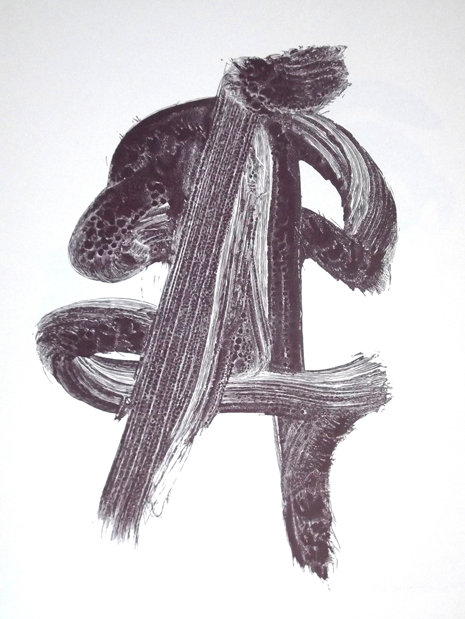Summary of an interview with the xylographer Rudolf Rieß who was born in Nuremberg in 1935. The interview was conducted on 01/18 and 01/19/2013 during a xylographic workshop of the Stuttgart State Academy of Art and Design in Bodman.
Rudolf Rieß is the last practicing xylographer who learnt the craft of xylography as a skilled trade. When he started his apprenticeship in Nuremberg in 1949, the professional group of xylographers was strongly depleted in Germany. Halftone had to a large extent replaced xylography. Most xylographers switched to this field of chemigraphy. Yet there was still a demand for xylography, which had become specialised in technical depictions, especially in the area of catalogue reproductions. Even as late as the 1950s, xylography still by far exceeded chemigraphical screen reproduction in regard to the sharpness of details.
During the course of his apprenticeship, Rieß had also made attempts to copy late xylographs by Albrecht Dürer employing the original technique. These attempts led him to the firm conviction that Dürer’s very finely hatched graphics are not xylographs but wood engravings. However, this thesis could not be substantiated to date based on an examination of the printing blocks.

Rudolf Rieß, Bodman, Januar 2013

Albrecht Dürer, Der heilige Hieronymus in der Studierstube, Holzschnitt, Basel 1492 (Ausschnitt)

Albrecht Dürer, Der heilige Hieronymus in der Studierstube, Holzstich (?), Nürnberg 1511 (Ausschnitt)
After completing his training, Rieß was employed by the large publishing and printing house Theodor Körner in Stuttgart. From 1920 onwards, Körner had made a name for itself nationally through the publication of the legendary xylographic specialist magazine “Der Holzschnitt”. Shortly after the National Socialists came to power, however, the magazine was discontinued, since the editors had not accepted to publish an imposed portrait of the Führer. The page in question was pasted over with an empty sheet and the issue was sold without Hitler’s likeness

Werbeprospekt der Graphischen Kunstanstalt Theodor Körner mit Arbeitsproben, Stuttgart, undatiert (Slg. R. Rieß)

Heinz Schmelzkopf, Porträt Adolf Hitler (unkaschiert), Der Holzschnitt, Monatsschrift zur Pflege und Förderung des Holzschnitts, Nr. 81, Stuttgart, April 1932, S. 12 (Slg. R. Rieß)

Kaschiertes Hitler-Porträt, Der Holzschnitt, Monatsschrift zur Pflege und Förderung des Holzschnitts, Nr. 81, Stuttgart, April 1932, S. 12 (Slg. R. Rieß)
After the Second World War, Stuttgart assumed Leipzig’s legacy as the centre of xylography in West Germany. The reproduction trade was pursued on the highest possible level here. At the Körner publishing house, Rudolf Rieß met the master xylographer Kurt Wiedenmann, whose brilliant technical xylographs were internationally esteemed. He then encountered Willi Seidl, the last and most extreme proponent of artistic photo xylography. Seidl had been at the Stuttgart State Academy of Art and Design from 1931-34, where he was trained by the workshop teacher for xylography, Julius Heilenmann. Both were then involved in the production of the legendary study collection “Der Wassermann“ by the famous typographer Ernst Schneidler. Later, Rudolf Rieß assisted Willi Seidl in the photographic exposures of the originals on the printing blocks and also helped him with one of the most significant reproduction commissions of the time, the xylographic transfers of Max Beckmann’s illustrations for Goethe’s Faust, published in 1957. Beckmann wanted the almost imperceptible pencil lines of the tracing to be retained in the reproduction, in addition to the high-contrast lines of the original pen and ink drawing. At the time, halftone could not accomplish this.

Kurt Wiedenmann, Holzstich, in: David M. Sander, Wood Engraving. An Adventure in Printmaking. New York, 1982 (MePri-Coll.)

Kurt Wiedenmann, Schere, Holzstich (Probedruck, undatiert), für: Lawton, Surgical Insruments Catalogue, New York (Slg. R. Rieß)

Firma Theodor Körner, Holzstich, Feilen, Katalog der Firma Dick, Esslingen, 1926 (Ausschnitt) (Slg. R. Rieß)

Willi Seidl / Rudolf Rieß, Holzstich, 1957, nach: Max Beckmann, Faust und Helena, Federzeichnung, 1943 (Slg. R. Rieß)

Willi Seidl / Rudolf Rieß, Holzstich, 1957, nach: Max Beckmann, Faust und Helena, Federzeichnung 1943 (Ausschnitt) (Slg. R. Rieß)
In the years that followed, Seidl specialised in the elaborate reproduction of contemporaneous art, including many abstract originals. During the times of industrial reproduction and informal vehemence, Seidl’s art of sophisticated manual reproduction was dismissed as totally anachronistic. He was troubled quite a bit with this ignorance. From today’s perspective, the very special quality of Seidl’s graphics lies in the extremely tensional relationship between the expressivity of the originals and the mimetic radicalness of the transfers. They were the point of culmination of a Stuttgart School of xylography that countered the monotony of industrial reproduction with a future-oriented diversity and innovativeness on the level of micro-structures.

Scheerer, Porträt Willi Seidl, Stuttgarter Nachrichten, 1967 (Zeitungsraster) (MePri-Coll.)

Willi Seidl, Holzstich, 1967, nach: Pablo Picasso, Weiblicher Rückenakt, 1958 (MePri-Coll.)

Willi Seidl, Holzstich, 1967, nach: Pablo Picasso, Weiblicher Rückenakt, 1958 (Ausschnitt) (MePri-Coll.)

Willi Seidl, Holzstich, 1962, nach: Eleonora Braig-Rozanek, Pinselzeichnung (MePri-Coll.)

Willi Seidl, Holzstich, 1962, nach: Eleonora Braig-Rozanek, Pinselzeichnung (Ausschnitt) (MePri-Coll.)

Walter Brudi, Russische Wäscherin, Aquarell, 1942 (Rasterreproduktion, in: Walter Brudi, Graphik Malerei, Stuttgart- Zürich, 1987)

Willi Seidl, Sechsfarben-Holzstich (undatiert, ca. 1961), nach: Walter Brudi, Russische Wäscherin, 1942 (MePri-Coll.)

Willi Seidl, Sechsfarben-Holzstich (undatiert, ca. 1961), nach: Walter Brudi, Russische Wäscherin, 1942 (Ausschnitt) (MePri-Coll.)

Willi Seidl, Holzstich (undatiert), nach: Walter Brudi, Hauptbahnhof Stuttgart (lavierte Zeichnung, 1945) (MePri-Coll.)

Willi Seidl, Schriftblatt, Holzstich, ca. 1933, in: Ernst Schneidler, Der Wassermann. Ein Lehrbuch für Büchermacher, Stuttgart 1945 (Slg. Kunstakademie Stuttgart)

Julius Heilenmann, Die Flucht, Holzstich (ca. 1945 ) (MePri-Coll.)

Julius Heilenmann, Die Flucht, Holzstich (ca.1945) (Ausschnitt) (MePri-Coll.)

Julius Heilenmann, Ewigkeit, Holzstich (ca.1945) (MePri-Coll.)

Julius Heilenmann, Ewigkeit, Holzstich (ca. 1945) (Ausschnitt) (MePri-Coll.)

Willi Seidl, Die Bergpredigt, Holzstich, 1948, nach einer lavierten Zeichnung von Hans Appelhans

Willi Seidl, Holzstich , Willi Seidl, Die Bergpredigt, Holzstich, 1948, nach einer lavierte Zeichnung von Hans Appelhans (Ausschnitt)
